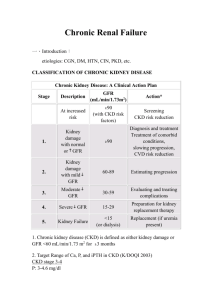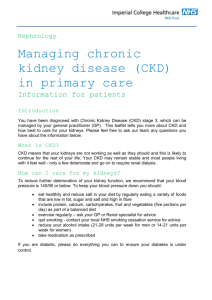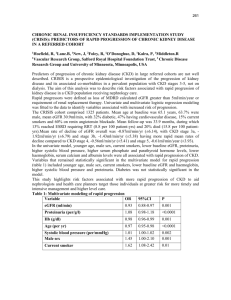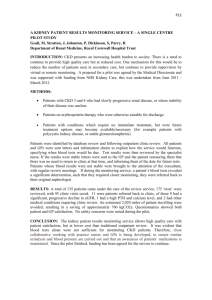CKD & Estimated Glomerular Filtration Rate (eGFR)
advertisement
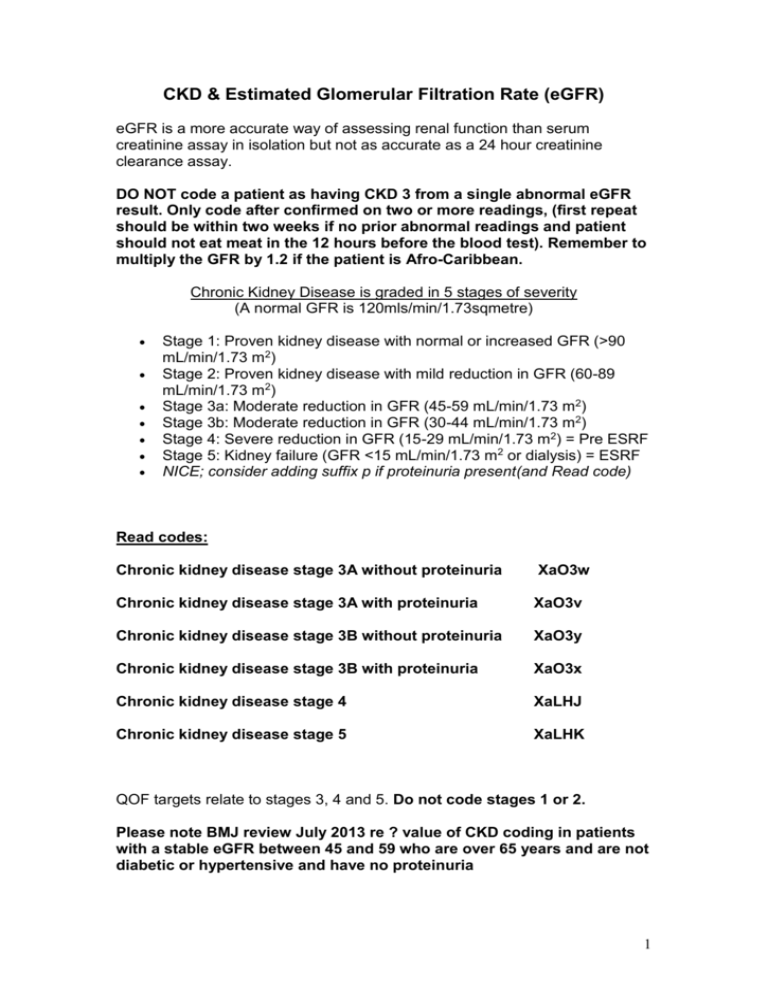
CKD & Estimated Glomerular Filtration Rate (eGFR) eGFR is a more accurate way of assessing renal function than serum creatinine assay in isolation but not as accurate as a 24 hour creatinine clearance assay. DO NOT code a patient as having CKD 3 from a single abnormal eGFR result. Only code after confirmed on two or more readings, (first repeat should be within two weeks if no prior abnormal readings and patient should not eat meat in the 12 hours before the blood test). Remember to multiply the GFR by 1.2 if the patient is Afro-Caribbean. Chronic Kidney Disease is graded in 5 stages of severity (A normal GFR is 120mls/min/1.73sqmetre) Stage 1: Proven kidney disease with normal or increased GFR (>90 mL/min/1.73 m2) Stage 2: Proven kidney disease with mild reduction in GFR (60-89 mL/min/1.73 m2) Stage 3a: Moderate reduction in GFR (45-59 mL/min/1.73 m2) Stage 3b: Moderate reduction in GFR (30-44 mL/min/1.73 m2) Stage 4: Severe reduction in GFR (15-29 mL/min/1.73 m2) = Pre ESRF Stage 5: Kidney failure (GFR <15 mL/min/1.73 m2 or dialysis) = ESRF NICE; consider adding suffix p if proteinuria present(and Read code) Read codes: Chronic kidney disease stage 3A without proteinuria XaO3w Chronic kidney disease stage 3A with proteinuria XaO3v Chronic kidney disease stage 3B without proteinuria XaO3y Chronic kidney disease stage 3B with proteinuria XaO3x Chronic kidney disease stage 4 XaLHJ Chronic kidney disease stage 5 XaLHK QOF targets relate to stages 3, 4 and 5. Do not code stages 1 or 2. Please note BMJ review July 2013 re ? value of CKD coding in patients with a stable eGFR between 45 and 59 who are over 65 years and are not diabetic or hypertensive and have no proteinuria 1 Any patient with two eGFR of < 60 should have their CKD stage coded and the Problem Page updated. Code as having proteinuria if ACR > 30. Any patient suspected of having CKD 3 or worse should have an abdominal and cardiovascular examination, BP check, diabetes screen (fasting BS or HbA1c if not already known diabetes), dipstick for haematuria (NICE: do not use MSU to confirm a positive result, simply repeat the dip test on another sample, as a positive result = 1+ or more haematuria on two occasions) and a urinary Albumin Creatinine Ratio on early morning sample. If the patient is not hypertensive or diabetic then consider arranging a renal USS * and once the result is available consider referral to a renal physician. A FBC is only required in patients found to have eGFR < 45 i.e. CKD3b or worse. *NICE suggest imaging with USS if; haematuria, progressive CKD, symptoms suggesting obstruction of if there is FH renal disease. Current referral guidelines renal.org 2012 eGFR 60 + – referral not required unless other problems present e.g genetic disorder eGFR 30-59 – routine referral if Documented progressive eGFR > 5ml/min/1.73m2 over 12 months (needs 3 or more eGFR tests) Microscopic haematuria Elevated ACR (>70mg/mmol in non diabetics) Unexplained anaemia, or abnormal K Uncontrolled BP > 150/90 on four agents Suspected systemic illness, such as SLE Suspected renal artery stenosis Suspected genetic cause CKD eGFR 15-29 eGFR <15 - urgent referral - immediate referral (?admit) Information to send with referral: General medical history - particularly noting urinary symptoms, previous blood pressures, urine testing. Medication history Examination Urine dipstick result for haematuria and quantitation of proteinuria by ACR or PCR Blood tests results - Full blood count, urea and electrolytes. HbA1c if diabetic. If available, calcium, albumin, phosphate, cholesterol. Previous tests of renal function with dates, back to normal renal function if possible (if not available electronically to specialist) Imaging - results of renal imaging if undertaken 2 Management of patients with chronic kidney disease (CKD3a and below) in primary care involves: Bear in mind the dubious value of CKD coding in patients with a stable eGFR between 45 and 59 who are over 65 years and are not diabetic or hypertensive and have no proteinuria In patients likely to benefit Reassure and explain to patients the concept of CKD. Only 4% of patients with CKD3 will progress to end stage renal failure. The older the patient, the lower the risk. Evidence for stains reducing CVD risk in CKD (primary prevention) is limited BUT 2104 draft NICE guidance advocate CVD risk assessment in the patients under 50 and Atorvastatin 20mg (in patients over 50) and an increase in dose to 40mg if non HDL cholesterol does not fall > 40% Secondary CVD prevention in CKD - 2104 draft NICE guidance advocate Atorvastatin 20mg and an increase in dose to 40mg if non HDL cholesterol does not fall > 40% Meticulous control of hypertension if present. Audit standard <140/<85 (=QOF target 2014). Antihypertensives: If BP elevated and ACR < 30 in non diabetics, treat as per NICE guideline (A, C, D guidelines). If BP elevated and ACR > or = to 30 or if the patient is diabetic, commence ACE (or ARB) as first line treatment. Check eGFR before treatment, 1-2 weeks after starting and after each dose increase. Consider stopping this therapy if GFR falls by 25% or potassium rises over 6.0 and arranger Doppler USS to exclude renal artery stenosis. (Remember that the value of ACE/ARBs is debatable in hypertensive non-diabetic who have a urinary ACR < 30mg/mmol or non hypertensive/non diabetics with urinary ACR < 70 mg/mmol. However, don’t forget the current QOF target, CKD 003 = % of patients on CKD register with hypertension & proteinuria on ACE/ARB. Target 45-80%). 3 Regular measurements of kidney function using serum creatinine concentration and estimated GFR with urinary ACR, depending on the severity of kidney impairment (annual in unilateral kidney, stage 1 & 2 CKD or ‘any cause’ stage 3 CKD if known to be stable, 6-monthly for newly diagnosed or stage 3b or worse. Also a FBC is required in patients found to have eGFR < 45 i.e. CKD3b or worse. Initial and then annual CVD risk assessment if not on a statin. Advice on smoking cessation. Advice on weight loss if obese and a lower salt diet. Encouragement to take regular aerobic exercise Advice to limit alcohol intake to no more than 3 units/day (men) or 2 units/day (women). Pneumovac (single dose) & flu vaccination annually Lipid lowering as per NICE 2008. Regular review of all prescribed medication, to ensure appropriate dose adjustments and the avoidance, wherever possible, of nephrotoxic drugs, including NSAIDs. Consider adding a Major alert or a sensitivity regards not using Nitrofurantoin CKD 3b & 4 requires in addition to the above: Annual FBC Annual measurement of calcium, phosphate for CKD4 (usually performed by secondary care, as these patient should be under renal team review) Treatment of anaemia. If due to renal disease it should be normocytic and normochromic (if not investigate as any other anaemia). If normocytic and normochromic and a serum ferritin > than 15mcg/l but < 100 in the absence of other potential underlying causes consider starting oral iron and aim for a ferritin level of > 100. If the Hb falls below 11 despite this or if the patient has symptoms of anaemia then they may need intravenous iron ± erythropoiesis stimulating agents (ESAs), after exclusion of other causes of anaemia. Immunisation against influenza and pneumococcus (CKD 4 and below requires 5 yearly pneumovac). Regular review of all prescribed medication, to ensure appropriate dose adjustments and the avoidance, wherever possible, of nephrotoxic drugs, including NSAIDs. Annual Review Record smoking status and code smoking cessation advice if appropriate BP (Audit standard <140/<85). 4 Blood and urine investigations as per table Document CVD risk assessment (if not already on a statin) and lifestyle advice Should they be on an ACE or ARB? Has there been a progressive decline in their e-GFR (Do they need referral?). The patient pathway Patients, as a result of remembering their annual review date or having a reminder on their prescription will ring to book their annual review. The reception team will book a bloods & BP appointment with one of the HCAs. The HCAs will review the patients co-morbidities using the SystmOne chronic disease icons page (checking for COPD, Asthma, HT, IHD/TIA/CVA) to decide the tests they have to perform. They will also arrange a 20 minute review with a Practice Nurse if they have CKD +/- hypertension but a 30 minute appointment if they have asthma, COPD or a history of MI, angina, TIA or stroke. The Practice nurses on completing the annual review, where no action is deemed to be necessary, will also document and inform the patient of their next planned review date and task the appropriate GP to code the medication review and reauthorise prescriptions for an appropriate interval. Patients requiring further assessment or a change in medication will be referred to the GP. QOF 2014-2015 QOF content threshold % points CKD001 register n/a 6 CKD 002 BP<140/85 41 – 81 11 CKD003 hypertension # 45 – 80 9 CKD004 ACR within 12/12 45 – 80 6 # % patients on CKD register with hypertension and proteinuria treated with ACEI / ARB unless contraindicated / intolerant 5 Useful links http://www.renal.org/; UK CKD e-guide; revised Jan 2009.This combines guidance from NICE, SIGN, Renal Association. Also links from home page to patient info leaflets. http://www.pennine-gp-training.co.uk/Chronic-Kidney-DiseaseExplained.doc Something for the future? Cystantin C blood levels in combination with eGFR may be used to identify patients at risk of renal disease progression in the future. 6



